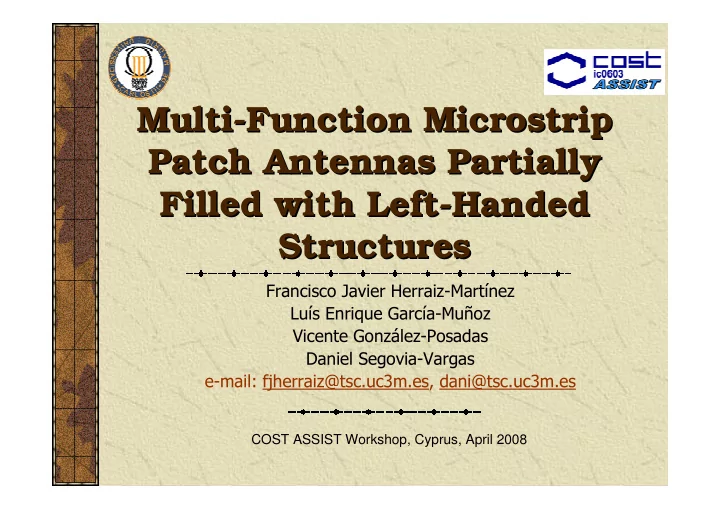

Multi- -Function Function Microstrip Microstrip Multi Patch Antennas Partially Patch Antennas Partially Filled with Left- -Handed Handed Filled with Left Structures Structures ��������������������������������� ������������������������� ������������������������ ��������� �������� �� ��!���"�#$%������&���'��(!'��)�����&���'��(!'�� COST ASSIST Workshop, Cyprus, April 2008
Outline Outline Introduction Objective Terminology TL Model of proposed patches Triple-frequency and dual-mode patch antenna Dual-frequency patch antenna Polarization diversity Multi-frequency and dual polarization Dual-frequency CP patch antennas Conclusion 2
Introduction Introduction Wireless services have grown dramatically in the last years. Objective: Development multi-function patch antennas Simultaneous operation at different frequencies. Patch-like and monopolar (null at broadside) radiation patterns at different working frequencies. Arbitrary selection of frequencies. Compact antennas � Integration into handheld devices. Terminology: (a) RH (Right-Handed) or Conventional Materials: ( E , H , � ) form a right-handed triplet. • ( E , H , S ) form a right-handed triplet. • • Equivalent circuit of a RH TL section: series L and shunt C. � > 0 and � � proportional to �� • (b) LH (Left-Handed) or DNG (Double Negative) Metamaterials: ( E , H , � ) form a left-handed triplet. • ( E , H , S ) form a right-handed triplet. • • Equivalent circuit of a LH TL section: series C and shunt L. � < 0 and � � proportional to 1/ �� • 3
TL Model Model of of TL proposed patches patches proposed Proposed approach: RH+LH+RH TL Resonant condition: � n L = � n RH d + � n LH � = n � with � RH �� k 1 f and � LH ��� k 2 /f Additional modes below the conventional frequency are obtained: | � RH d| < | � LH � | � n = – 1 ( � n L = - � ) • | � RH d| = | � LH � | � n = 0 ( � n L = 0 ) • The conventional modes are also present: | � RH d| > | � LH � | � n = +1, +2, … • 4
Triple- -frequency frequency Triple antenna antenna The simplest antenna based on previous model is a squared patch partially filled with 2 LH cells. The LH cells are implemented by using a rectangular version of the Sievenpiper’s mushroom structure: Slots are made inside the patch to define the cells. Each cell is grounded with a via. Modes n = -1, 0 , +1 are excited. n = ± 1 are patch-like modes. n = 0 is a monopolar mode. 5
Triple- -frequency frequency Triple antenna antenna 6
Dual- -frequency frequency Dual antenna antenna 7
Polarization Polarization diversity diversity In all the previous designs, only one polarization has been used (TM n 0 modes). It is possible to excite modes with two orthogonal polarizations (TM n 0 and TM 0 m modes). This can be used to develop patch antennas with interesting properties: Dual-band CP antennas: • With two feeds and external circuitry. • With one feed. Quad-band antennas with two orthogonal polarizations (frequency and/or polarization diversity): With two ports and high isolation between ports. � Application: • self-diplexed patch antennas. • With one port. 8
Polarization Polarization diversity diversity 9
Multi- -freq freq. . and and Multi dual- -polarization polarization dual 10
Multi- -freq freq. . and and Multi dual- -polarization polarization dual 11
Dual- -freq freq. CP . CP Dual patches patches Two approaches: (a) Two ports and external circuitry. (b) Perturbations in the patch: � Slightly rectangular patches ( W L ) • • Small squares. • Etc. 12
Conclusion Conclusion Multi-frequency patch antennas have been developed by partially filling a conventional patch with left-handed cells. The working frequencies can be arbitrarily chosen and they depend on the lengths of the patch and the cells. These antennas can be used for interesting applications: polarization/frequency diversity, dual-band CP patch antennas, self-diplexed patch antenna, etc. 13
THANK YOU 14
Recommend
More recommend